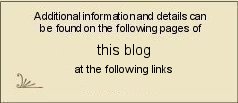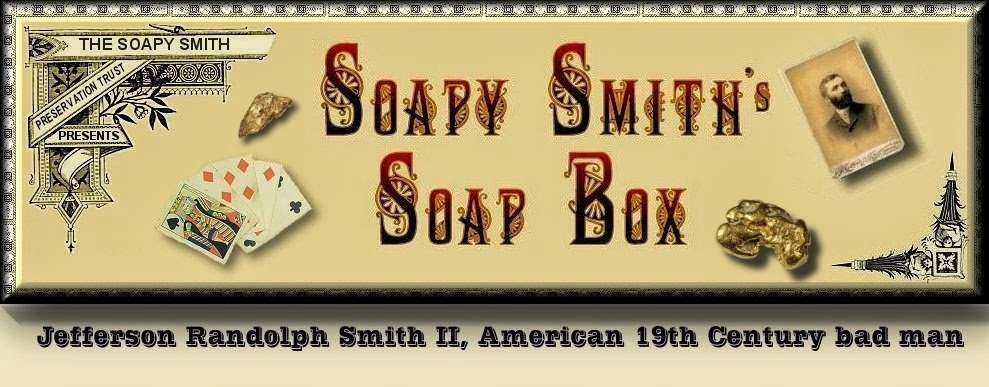Mitch Morrissey, a Facebook friend and historian for the Denver District Attorney’s Office, found and published an interesting newspaper piece on "Big Ed" Burns, one of the most notorious characters in the West. Burns was a confidence man and crime boss who is believed to have met Jefferson Randolph "Soapy" Smith in Tombstone, Arizona, or one of the surrounding towns in 1882 where Burns was the boss of the top and bottom gang best known in and around the Benson area. Burns later joined Soapy in Denver and followed him to Creede and Alaska.
In 1889 a man was shot and killed in the Palace Theatre which was run by Bat Masterson at 15th and Blake Streets in Denver. Burns and some of his men were in the house at the time and before the victim of the unknown assassin had breathed his last. Burns took the opportunity to rob the fallen man of a large diamond stud. Burns escaped the officers and before it was reported to Denver District Attorney Ledru R. Rhodes (1886-1889) he left Denver and was never punished for the offense.
How much of the newspaper article is accurate? Below is the text of the newspaper article. Following the article is some research information I have found over the decades.
The Morning Times
Cripple Creek, Colorado
February 15, 1896
[The following information comes from Alias Soapy Smith: The Life and Death of a Scoundrel]
In 1889 a man was shot and killed in the Palace Theatre which was run by Bat Masterson at 15th and Blake Streets in Denver. Burns and some of his men were in the house at the time and before the victim of the unknown assassin had breathed his last. Burns took the opportunity to rob the fallen man of a large diamond stud. Burns escaped the officers and before it was reported to Denver District Attorney Ledru R. Rhodes (1886-1889) he left Denver and was never punished for the offense.
How much of the newspaper article is accurate? Below is the text of the newspaper article. Following the article is some research information I have found over the decades.
The Morning Times
Cripple Creek, Colorado
February 15, 1896
So how accurate is the Cripple Creek newspaper?CHIEF OF “CONS.”Big Jim Burns, Gold-Brick Swindler, Visits Cripple Creek and Sleeps in Jail.
"Big" Ed Burns, one of the most notorious characters in the West, was arrested last night by Officers Clark and Reynolds. Burns is known all over the United States, and has been known to turn a bunco trick in St. Louis and Chigago [Chicago] on the same day. He will do anything from robbing a coop to a gold brick swindle. He was in Leadville in the early days and was mixed up in a killing in Chicago. He has been chased out of all the larger cities in the West, but strange as it may seem, has only done about eight years all told. He usually has a gang of men around him that are as desperate as himself, and the community where they stop suffer greatly from the depredations inflicted by these men.
In 1889 a man was shot and killed in the Palace theatre In Denver, which was then run by Bat Masterson. Burns and some of his men were in the house at the time and before the victim of the unknown assassin had breathed his last, Burns had robbed him of a large diamond stud. He escaped the officers and left the country and was never punished for the offense. He has been arrested for robbing hen roosts and selling brass bricks for solid gold.
The brick scheme was worked by him more successfully than his other games, as he invariably caught his man at night and sold him the bricks under the shades of darkness. His appearance helped him on his scheme no [?] and when he was making a "front," would resemble a man of considerable means. He is about six feet one inch tall, has a rather good-looking face. His stomach is enormous and he weighs about 240 pounds. When he "lies up" for a front he wears a silk hat, a long Prince Albert coat, patent leather shoes and on his shirt front a cluster of diamonds. He also wears a very large diamond ring on his right little finger and carries a heavy gold headed cane in the same hand.
When dressed thus, he is ready to sell gold bricks. When working this he stops at the best hotel in the city and becomes acquainted with all the prominent men stopping there. He picks out a man who he thinks is the easiest worked, and in confidence tells him about some gold bricks which he-owns. He don’t want to sell them, O no, but would like to borrow some money on them. The man would look at them and that night they would take the bricks in a grip and go out of the city limits to be away from prying eyes. Here they would open the grip, take out the bricks and with a file scrape the edges into a paper and take these to the city to have them tested. Of course the filings would be gold and the next night the money would be loaned. When the time expired for the bricks to be redeemed the man who held them took them to the mint or a jeweler to be sold, where he found their spurious nature. In the meantime Burns would be swelling around another part of the country on the money gained in this way.
Where Burns has been for the past three years no one seems to know. He arrived yesterday morning and slept in jail last night. He arrived alone but his men are supposed to be on the way and they will be "landed" as soon as they arrive. The charge of vagrancy is placed against him and he will be given hours to leave. He says he came in from Pueblo, but it is thought he came from Oklahoma.
[The following information comes from Alias Soapy Smith: The Life and Death of a Scoundrel]
- Burns’ first known arrest in Denver was in June 1883. During a second arrest two months later, he escaped in handcuffs.
- In 1887 while in Santa Monica and Los Angeles, he was arrested at least three times and was the defendant in the first recorded court case of the shell game in Los Angeles.
- In Denver in late April, early May 1889, Burns received fifteen days for stealing a valise.
- Within two months he was arrested for waving a pistol around on 32nd and Holladay streets, vowing to shoot someone. His wife had run off with another man, and he was searching for them.
- In 1890 Burns was in Denver where he was known as a smooth operator. On July 16, 1890, Chief of Detectives Loar gave him twenty-four hours to leave the city [note that I do not include the 1889 dying man robbery. I did not find the story in Denver newspapers].
- Burns then vanished until 1892 when he showed up in Creede, probably as a member of the soap gang. He dropped in and out of the gang as he traveled around the state.
- In February 1896 he was with Jeff and “ten fierce men” when arrested for vagrancy in Cripple Creek and ordered to leave [this is likely the foundation of the newspaper article in The Morning Times].
- On March 10, 1896, in Denver, he witnessed the saloon shooting of Aquilla “Dick” Hawkins. The Denver Evening Post wrote, “He was never suspected of earning a dollar honestly, and was always regarded as a crook who might be guilty of committing any crime from petite larceny to murder.”
MY THOUGHTS
For the most part the Morning Times article is accurate in regards to Burns' past in Chicago, Leadville, etc. It's hard for me to accept the story regarding the Palace Theater and Burns' robbery of the dying man, based on the lack of a Denver newspaper confirmation. I'm not saying it didn't happen though. The date and vagrancy charge is true, but something the newspaper missed is that Burns was traveling with Jefferson Randolph "Soapy" Smith who apparently escaped notice in the papers.
Nov 13, 2009
Feb 10, 2010
May 20, 2010
Sep 12, 2010
Apr 07, 2011
Apr 04, 2020
"Big Ed" Burns: pages 43, 77-79, 101-02, 120, 176, 210, 405, 487, 489, 571.
"Horse sense is a good judgment which keeps horses from betting on people."
—W.C. Fields










.jpg)





































